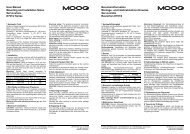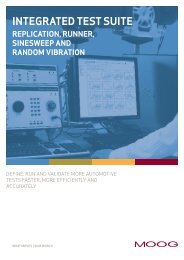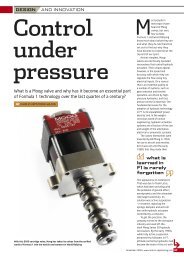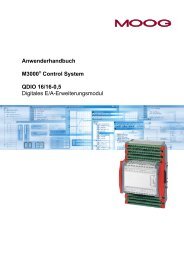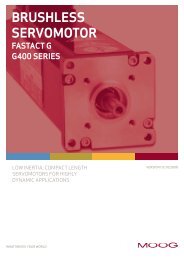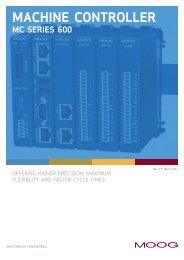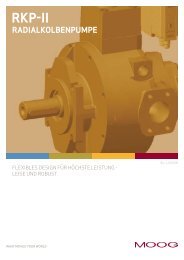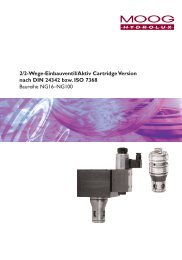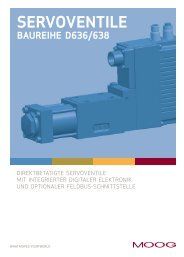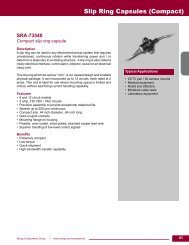User Manual M3000® Automation System / MSC II (Moog Servo ...
User Manual M3000® Automation System / MSC II (Moog Servo ...
User Manual M3000® Automation System / MSC II (Moog Servo ...
Create successful ePaper yourself
Turn your PDF publications into a flip-book with our unique Google optimized e-Paper software.
3 Short M3000 ® <strong>System</strong> Overview M3000 ® <strong>System</strong> Architecture<br />
• MACS (<strong>Moog</strong> Axis Control Software)<br />
Development environment according to IEC 61131 for solving complex<br />
control tasks<br />
�-"3.5-Application Programs" on page 25<br />
• MACS HMI (<strong>Moog</strong> Axis Control Software Human Machine Interface)<br />
Visualization package which can be run without MACS<br />
�-"3.6.1-MACS HMI Visualization Package" on page 26<br />
The M3000 ® modules mentioned here represent only a part of <strong>Moog</strong>'s<br />
current product range. In addition to other M3000 ® modules, <strong>Moog</strong>'s<br />
product range includes a large variety of accessories.<br />
�-"11-Product Range" on page 114<br />
3.1 M3000 ® <strong>System</strong> Architecture<br />
The M3000 ® automation system has the hardware and software structure<br />
necessary for modular and flexible automation solutions with distributed intelligence.<br />
The <strong>MSC</strong> <strong>II</strong> control module can use an Ethernet connection (LAN, company<br />
network, peer-to-peer connection) to communicate with another controller,<br />
development environment, or visualization package.<br />
�-"7.1-Ethernet" on page 47<br />
�-"10.5.1-Communication Between <strong>MSC</strong> <strong>II</strong> and MACS" on page 84<br />
�-"10.5.1.1-Ethernet Communication Interface" on page 84<br />
To create real time capable applications, even in distributed systems and to<br />
give the application a better structure, M3000 ® can also be divided hierarchically.<br />
�-"7.5-CAN Bus and CANopen" on page 55<br />
WideCAN and LocalCAN are two equal, mutually independent CAN bus interfaces.<br />
In a typical application they are used as follows:<br />
• WideCAN can be used for networking of individual control groups or remote<br />
modules. Usually, WideCAN is used for synchronization and data<br />
exchange between the control groups and operating stations of a machine<br />
or system.<br />
�-"3.3.4-R-Modules (Remote Modules)" on page 19<br />
�-"7.7.4-WideCAN Bus Groups" on page 67<br />
In addition, the WideCAN network can integrate other components with<br />
a CAN bus or CANopen interface, such as motor controllers, hydraulic<br />
valves, and radial piston pumps.<br />
• LocalCAN connects the DIN rail modules within a LocalCAN bus group<br />
and, if applicable, the QEBUS-CAN to the connected LocalCAN bus<br />
groups or CAN sensors/actuators.<br />
�-"3.3.3.2-QEBUS-CAN" on page 19<br />
�-"7.7.3-LocalCAN Bus Groups" on page 66<br />
M3000 ® <strong>System</strong><br />
Architecture<br />
Ethernet<br />
CAN Bus<br />
WideCAN<br />
LocalCAN<br />
© <strong>Moog</strong> GmbH <strong>User</strong> <strong>Manual</strong> M3000 ® and <strong>MSC</strong> <strong>II</strong> (CA65865-001; Version 1.1, 08/08) 14





